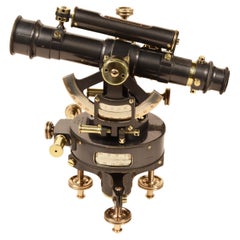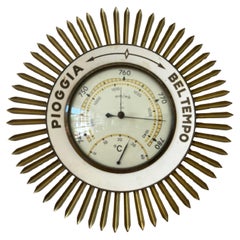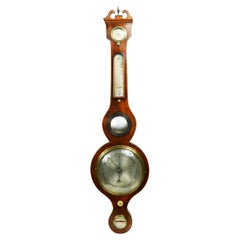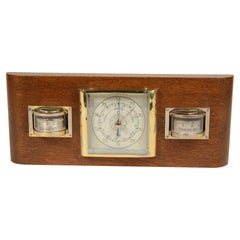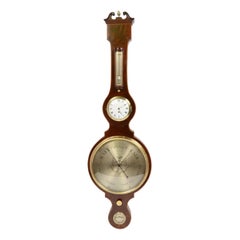Italy Scientific Instruments
to
8
289
938
595
289
20
3
3
2
1
1
1
1
1
1
23
114
152
54
84
12
2
11
8
16
4
18
8
12
138
122
63
62
52
232
104
41
35
31
289
289
289
6
4
3
2
2
Item Ships From: Italy
Tacheometro model Soldati late 19th c. signed La Filotecnica Milano
Located in Milan, IT
Tacheometer model Soldati from the late 19th century signed La Filotecnica Ing. A Salmoiraghi Milan serial no. 18865.
Construction site surveying and tracking tool used for calculati...
Category
Late 19th Century Antique Italy Scientific Instruments
Materials
Brass
Mid-Century Brass Wall Barometer, 1950s
Located in Palermo, IT
Mid-Century Brass Barometer, 1950s
Working and in good condition.
Category
1950s Italian Vintage Italy Scientific Instruments
Materials
Brass
Torricellian mahogany barometer signed Davis 65 Bold St. Liverpool 1839/1841
Located in Milan, IT
Torricellian mercury barometer in mahogany wood, signed Davis 65 Bold St. Liverpool active at this address from 1839 to 1841, complete with reading nonius for checking pressure varia...
Category
Mid-19th Century Antique Italy Scientific Instruments
Materials
Wood
Wood and glass wall barometer station signed Lufft 1950s
Located in Milan, IT
Table or wall-mounted wood and glass barometer station signed Lufft from the 1950s, made for the Italian market and consisting of aneroid barometer, thermometer and hygrometer.
Buono...
Category
1950s Vintage Italy Scientific Instruments
Materials
Wood
19th Century Mahogany Barometer F Somalvico Antique Weather Measuring Instrument
Located in Milan, IT
Barometer complete with clock signed F. Somalvico N ° 11 Brook Str. Holborn London datable between 1810 and 1820. Finely crafted mahogany wood case with cedar wood edges. Large silve...
Category
1810s British Antique Italy Scientific Instruments
Materials
Mahogany
Vintage Wood Geloso Television GT1014, 1950s, Italy
Located in Rome, IT
This GTV1014 was one of the first 21-inch b / w televisions produced by Geloso.
It uses the intercarrier system as an audio-video medium frequency. The chassis is mounted inside th...
Category
1950s Italian Mid-Century Modern Vintage Italy Scientific Instruments
Materials
Glass, Plastic, Wood
Gruchon & Emons Paris 1918 magnetic compass for U.S Engineer Corps
Located in Milan, IT
Rare nautical survey magnetic compass, brass pocket, signed Gruchon & Emons Paris No. 81 1918, made for U.S Engineer Corps and in use by officers during World War I. This is a smal...
Category
1910s Vintage Italy Scientific Instruments
Materials
Brass
A botanic model Brendel, Germany 1900.
Located in Milan, IT
A rare botanical model of the Brendel, Conium maculatum N.60 (Umbelliferae). The round base in ebonized wood holds the botanical model which reveals the flower of the Hemlock. Brende...
Category
Early 20th Century German Italy Scientific Instruments
Materials
Wood
Traveler's pocket compass, Victorian-era turned brass
Located in Milan, IT
Traveler's pocket compass, Victorian-era turned brass, late 19th century England, rose on sixteen-twenty copperplate engraving paper complete with goniometric circle.
Conservation s...
Category
1890s Antique Italy Scientific Instruments
Materials
Brass
1930s Educational Model Depicting the Belly of the Woman Immediately After Birth
Located in Milan, IT
Educational model depicting the belly of the woman immediately after birth with a part of the placenta. 1930's, sold by the Hygiene Museum in Dresden...
Category
1930s Vintage Italy Scientific Instruments
Materials
Plaster
XIX Century English Mahogany Apothecary Set Cabinet Medicines J Hexam Chymist
Located in Milan, IT
English apothecary cabinet dated to the first half of the nineteenth century, mahogany box, brass handle and hinges and complete with key. The cabinet with a rectangular base is form...
Category
19th Century British Antique Italy Scientific Instruments
Materials
Mahogany
Induction electrification demonstrator instrument, Italy 1920.
Located in Milan, IT
Induction electrification demonstrator instrument. By putting two electrically neutral spheres in contact with each other, when a charged wand is approached, it is possible to notice...
Category
Early 20th Century Italian Italy Scientific Instruments
Materials
Blown Glass
Italian Telegraph in Solid Brass, 1880
Located in Palermo, Sicily
Italian Telegraph in solid brass, 1880.
Category
1880s Italian Art Nouveau Antique Italy Scientific Instruments
Materials
Brass
$2,913 Sale Price
30% Off
Pair of English 12-inch Globes by William Harris, London, 1832 and 1835
By William Harris
Located in Milano, IT
Pair of 12-inch table globes
William Harris
London, 1832 and 1835
Slight abrasions from use; few cracks
lb 11 each (kg 5)
The two terrestrial and celestial globes rest in their original Dutch style stands with four supporting turned wood columns.
Each one measures 12 in in height x 16.5 in in diameter with the diameter of the spheres measuring approximately 12 in; 48 cm in height x 42 cm in diameter x 31 cm diameter of the spheres.
The 12 inch measure was the most frequently used by British manufacturers of globes of this period.
Each globe is composed of two series of twelve printed paper gores, aligned and glued onto plaster spheres.
The brass circle of the meridian bears engravings...
Category
1830s English William IV Antique Italy Scientific Instruments
Materials
Paper, Wood
Mechanical planetarium representative of the solar system with Sun Earth and Moon
Located in Milan, IT
Mechanical planetarium, or representative model of the solar system, from the second half of the 19th century.
The cartouche of the globe reads: GlobusVydal J. Felkl at Syn Roztok ...
Category
1860s Antique Italy Scientific Instruments
Materials
Metal
English Pocket Globe, London, Circa 1775-1798
By Herman Moll
Located in Milano, IT
Pocket globe
London, between 1775 and 1798
Re-edition of the globe of Hermann Moll (1678-1732) dated 1719
The globe is contained in its original case, which itself is covered in shark skin.
There are slight gaps in the original paint on the sphere. The case no longer closes.
The sphere measures 2.7 in (7 cm) in diameter whereas the case measures 2.9 in (7.4 cm) in diameter.
lb 0.22 (kg 0.1)
The globe is made up of twelve printed paper gores aligned and glued to the sphere.
In the North Pacific Ocean there is a cartouche with the inscription:
A Correct
Globe
with the new
Discoveries.
The celestial globe is depicted on the inside of the box and is divided into two hemispheres with the cartouche:
A correct globe
with ye new cons
relations of Dr.
Halley & c.
It shows the ecliptic divided into the days of the zodiacal calendar and the constellations represented as animals and mythological figures.
On the globe are delineated the equinoctial line, divided by degrees and hours, the ecliptic and the meridian (passing west of Greenwich). The continents are shaded and outlined in pink, green and yellow. It shows: the Cook routes; a wind rose in the Southern Indian Ocean; Antarctica without land; Africa with Negroland (Hermann Moll is considered the first geographer to name the West African region in his 1727 map. (Encyclopaedia Britannica, ed. 1902, under "States of Central Africa"); Tartary in Central Asia; the Mogul kingdom in northern India; in North America only New England, Virginia, Carolina, Florida, Mississippi are identified; California is already a peninsula; the northwest coast of America is "unknown parts" (Alaska is not described and it is only partially delineated, it was to become part of the United States in 1867); Mexico is named "Spain"; Central South America "Amazone America". Australia (which was to be so named after 1829) is called New Holland. The route of Admiral Anson is traced (1740) and the trade winds are indicated by arrows. (See Van der Krogt, P., Old Globes in the Netherlands, Utrecht 1984, p. 146 and Van der Krogt, P. - Dekker, E., Globes from the Western World, London 1993, pp. 115.)
Elly Dekker, comparing Moll’s 1719 globe and his re-edition (of which the one described above is a sample), identifies the differences between them: the two editions are quite similar to each other, but in the "anonymous" globe, compared to the previous globe of 1719, California looks like a proper peninsula - the reports of the Spanish explorers of the region had given rise to uncertainty over whether it was connected to the mainland or not. The geographical nature of California was confirmed after the explorations of Juan Bautista de Anza (1774-1776). The routes of Dampier's journey were partially erased and the route of Captain James Cook's first voyage was superimposed on them, and the geography of Australasia was adapted accordingly, including the denomination of the Cook Strait. See Dekker, Elly, Globes at Greenwich, 1999.
An important ante quem element is represented by Tasmania: it is not separated from Australia by the Bass Strait...
Category
Late 18th Century English George III Antique Italy Scientific Instruments
Materials
Shagreen, Paper
18-inch Globe, Cary's, London, 1840
By Cary’s
Located in Milano, IT
John and William Cary
Updated by George and John Cary
Terrestrial Globe
London, 1840
lb 22 (kg 10)
Slight surface abrasions due to use. A small crack on the horizon circle.
The globe rests in its original Dutch style stand with four supporting turned wood columns.
It measures 26 in in height x 23.6 in in diameter with the diameter of the sphere measuring 18 in; 66 cm in height x 60 cm in diameter with the diameter of the sphere measuring 45.72 cm.
The 18 inch...
Category
1840s English Early Victorian Antique Italy Scientific Instruments
Materials
Paper, Wood
Brass Lorgnettes 'Long-Handled Opera Glasses' Mid-Century Italian Design 1930s
Located in Palermo, IT
A splendid pair of 'lorgnettes' (long-handled opera, or theatre, glasses). Lorgnettes, eye glasses held in place by long handles rather than resting on the bridge of one's nose, were...
Category
1930s Italian Vintage Italy Scientific Instruments
Materials
Brass
$456 Sale Price
20% Off
Pair of molecular atomic structure models. Leybold, Germany, 1940.
Located in Milan, IT
Pair of molecular atomic structure models for chemical didactic use. The spheres are made of painted wood and represent atoms and a molecule. The bases are in turned and ebonized fru...
Category
Mid-20th Century German Italy Scientific Instruments
Materials
Wood, Fruitwood
Anatomical model: a human skull model life size, Stuttgard, Germany 1930.
Located in Milan, IT
Human skull anatomical model life size 1:1 Model with cranial sutures detachable 2 parts plus three cervical vertebrae for medical educational aid. The skull and vertebrae are made o...
Category
Mid-20th Century German Italy Scientific Instruments
Materials
Iron
18th Century Diptych Portable Sundial And Compass by German Beringer
By David Beringer
Located in Milano, MI
Antique 18th Century Diptych Sundial and Compass a portable wooden boxwood sundial with compass, of German origin, by David Beringer, Nuremberg, dating back to the 1790 circa, in good age related condition, with signs of wear consistent with age and use.
David Beringer (1756 – 1821) was a German scientific instrument maker and craftsman active in Nuremberg and famous for his cubic wooden sundials visible in Metropolitan Museum of Art di New York.
A portable sundial...
Category
Late 18th Century German Antique Italy Scientific Instruments
Materials
Brass
Glass scientific instrument: Crookes maltese cross tube, Italy 1900.
Located in Milan, IT
Blown glass scientific instrument. An example of the Crookes tube with Maltese Cross, in chromed metal, a precursor to the cathode ray tube. It was used t...
Category
Early 20th Century Italian Italy Scientific Instruments
Materials
Metal
Vintage Panasonic Toot-a-Loop-Radio, 1970s
Located in Roma, IT
Vintage Panasonic toot-a-loop-radio is an original decorative object realized in the 1970s by Panasonic R-72 (R72) and built by Matsushita Electric Industrial Co
This radio is the...
Category
1970s Japanese Vintage Italy Scientific Instruments
Materials
Plastic
Cardboard round section telescope with four extensions and brass ferrules
Located in Milan, IT
Rare round cardboard scope with four extensions and brass ferrules, german manufacture from the early 19th century. Excellent state of conservation.
Maximum length cm 95 - 37.4 in,...
Category
Early 19th Century Antique Italy Scientific Instruments
Materials
Paper
Ptolemaic Armillary Sphere, Charles-François Delamarche, Paris, ante 1798
By Charles Francois Delamarche
Located in Milano, IT
Ptolemaic armillary sphere
Charles-François Delamarche
Paris, ante 1798
Wood and papier-mâché
covered with printed and partly hand-colored paper
It measures 15.55 in in height x Ø 10...
Category
1790s French Other Antique Italy Scientific Instruments
Materials
Wood, Paper
Ptolemaic Armillary Sphere, Charles-François Delamarche, Paris, ante 1798
By Charles Francois Delamarche
Located in Milano, IT
Ptolemaic armillary sphere
Charles-François Delamarche
Paris, ante 1798
Wood and papier-mâché
covered with printed and partly hand-colored paper
It measures 16.37 in in height x Ø 10.94 in (41.60 cm - Ø 27.80 cm)
It weights 2.33 lb (1,058 g)
State of conservation: consistent with its age and use, the paper shows some signs of use, stains and abrasions.
The sphere is Ptolemaic, with the Earth placed at its center, surrounded by the Moon and the Sun mounted on two metal arms.
The sphere is composed of six horizontal and two vertical rings (armillae), each bearing graduations and its own name.
The first horizontal ring is illegible. The others, in descending order are: North Pole, Tropic of Cancer, Equator, Tropic of Capricorn, South Pole.
The vertical rings consist of two double meridians.
The sphere is then connected to the large meridian by two pins, a vertical ring inserted perpendicularly into the circle of the Horizon, in turn supported by four semicircles connected to the turned and black-stained wooden base.
Each element is covered with printed paper. It contains various pieces of information: latitudes, length of days, names and zodiac symbols, calendar, wind directions, etc.
The vertical circles mention the latitudes and longitudes of different cities: Rome, Bordeaux, Madrid, Boston, Batavia (Jakarta), Acapulco, etc.
Even the small terrestrial globe is covered with printed paper: continents and oceans appear with numerous geographical markings indicating the most recent explorations.
In the Pacific Ocean, west of South America bears the following inscription:
GLOBE
TERRESTRIAL
à Paris
chez Delamarche Géog
Rue du Foin Jacques
Au Collège de
M.e Gervais
The North American coasts are well delineated and California appears correctly as a peninsula - reports from Spanish explorers in the region had given rise to confusion as to whether it was connected to the mainland or not. The geographical nature of California was confirmed after the explorations of Juan Bautista de Anza (1774-1776).
Alaska is not described and is only partially traced; it would become part of the United States in 1867.
Various Pacific islands are indicated.
Australia (the name definitely used from 1824) is called "Nouvelle Hollande."
Tasmania is still represented as a peninsula and this is an important detail for the dating of our armillary sphere.
The island is separated from Australia by Bass Strait, which was crossed by Matthew Flinders for the first time in 1798, showing that it was not a peninsula. Delamarche certainly would not have waited a long time to update such an important geographical datum: presumably he did so shortly after receiving the news.
Charles-François Delamarche (1740-1817) founded his laboratory around 1770 and, in a few years, he became the most famous French cartographer and globe maker between the 18th and 19th centuries. After having acquired the laboratory of the late Didier Robert de Vaugondy (1723-1786; himself a renowned cartographer who continued the family business founded by his grandfather Nicolas Sanson in the seventeenth century) and after having purchased, between 1788 and around 1800, the businesses of Jean-Baptiste Fortin (1750-1831) and Jean Lattré (around 1750-1800), he began to call himself "Successeur de MM. Sanson and Robert de Vaugondi, Géographes du Roi and de M. Fortin, Ingénieur-mécanicien du Roi pour les globes et les sphères."
Thus, at the end of the eighteenth century, Delamarche possessed the warehouse stocks, as well as the manufacturing skills of the globes of his main rivals in Paris.
In addition to this aggressive acquisition policy, the key to its success also lay in the combination of high-quality cartography combined with extremely attractive globes and armillary spheres; and, of course, its famous red paint finishing touch.
His laboratory was located on Rue de Foin St Jacques "au Collège Me. (or "Mtre") Gervais" in the Latin Quarter of Paris until around 1805, when he moved to rue du Jardinet No. 13.
On the death of Charles-François in 1817, the reins of the company passed to his son Félix (1779-1835), who continued to publish, often in collaboration with the engraver Charles Dien, Sr. In 1835 the company first moved to rue du Jardinet No. 12 and a little later to rue du Battoir No. 7.
Bibliography:
Dekker, Elly, et al. Globes at Greenwich...
Category
1790s French Other Antique Italy Scientific Instruments
Materials
Wood, Paper
Italian Modern Wooden Botanic Model
By Robert Brendel
Located in Roma, IT
A botanic didactical specimen in the manner of the famous German botanist Robert Brendel.
"In the late 19th century Robert Brendel and his son Reinhold produced beautiful and accur...
Category
Mid-20th Century Italian Mid-Century Modern Italy Scientific Instruments
Materials
Wood
A trunk style travel apotecary cabinet in mahogany wood and brass, England 1790.
Located in Milan, IT
English travelling apothecary made of mahogany Sipo mahogany (Entandrophragma utile) and brass with a rectangular base, a front drawer, an opening to...
Category
Late 18th Century English Antique Italy Scientific Instruments
Materials
Brass
German Globe by C. Abel-Klinger, Nuremberg, circa 1860
By C. Abel-Klinger
Located in Milano, IT
Terrestrial globe
Artistic company C. Abel - Klinger
Nuremberg, circa 1860
H cm 31 x 22 cm (12.20 x 8.66 in); sphere 14 cm (5.51 in) in diameter
lb 2.30 (kg 1.04)
State of conservation: good. On the sphere there are slight visible signs of accidental bumping at the poles, as well as on New Guinea and England (vertical and more visible); some ink stains, especially at the South Pole and on the meridian that crosses North America.
The globe is composed of twelve whole gores of printed paper, juxtaposed and glued on a sphere made with a chalky base mixture.
The circle of the meridian, made of brass...
Category
1860s German Other Antique Italy Scientific Instruments
Materials
Wood, Paper
Italian Radiophonograph RR126 and Record Player by Castiglioni, Brionvega 1960s
By Achille & Pier Giacomo Castiglioni, Brionvega
Located in MIlano, IT
Italian Radiophonograph RR126 and Record Player by Castiglioni Brothers for Brionvega, 1960s.
RR126 radio phonograph and turntable with a rectangular wooden base with dark brown prof...
Category
1960s Italian Modern Vintage Italy Scientific Instruments
Materials
Metal
1930s Educational Model Papier Maché and Plaster Decipting a Baby Borning
Located in Milan, IT
Educational model, papier maché and plaster, decipting a baby borning. 1930s-1940s, sold by the Hygiene Museum in Dresden. Very good condition. Measu...
Category
1930s Vintage Italy Scientific Instruments
Materials
Plaster
Celestial Table Globe, Charles-François Delamarche, Paris, 1791
By Charles Francois Delamarche
Located in Milano, IT
Celestial table globe
Charles-François Delamarche
Paris, 1791
It measures: 17.13 in in height, Ø max 27.7 in; the sphere Ø 7.09 in
(h 43.5 cm x Ø max 27.7 cm; the sphere Ø 18 cm).
W...
Category
1790s French Other Antique Italy Scientific Instruments
Materials
Metal
German Medical or Tanning Lamp, Wood and Bakelite, 1940s
Located in Roma, IT
German medical or tanning lamp.
Transport handle and external thermometer.
Three settings of the lamps. Eight porcelain lamp holders and four light bulbs. Current 220 volt
Woo...
Category
1940s German Art Deco Vintage Italy Scientific Instruments
Materials
Porcelain, Bakelite, Wood
Box of mid-19th century compasses housed in their tuia burl box
Located in Milan, IT
Box of mid-19th century compasses, housed in their original tuia burl box, nickel-plated brass and ivory instruments, velvet and satin interior, lock and hinges in brass. Embossed ...
Category
Mid-19th Century Antique Italy Scientific Instruments
Materials
Wood
London Mid-19th Century Vanity Kit Set Sterling Silver
Located in Brescia, IT
Not easy to find this original box, with this kit set composed of 8 pieces for nail manicure. A piece to collect or to add in a wunderkammer.
In sterling silver, all marked.
With ce...
Category
Mid-19th Century British Baroque Antique Italy Scientific Instruments
Materials
Crystal, Sterling Silver
$356 Sale Price / set
25% Off
FER model logarithmic circular slide rule H 39 n. 1675 1930s
Located in Milan, IT
FER model logarithmic circular slide rule H 39 No. 1675 from the 1930s, Italian Patent No. 1680, housed in its original round-shaped wooden box like the instrument, complete with in...
Category
1930s Vintage Italy Scientific Instruments
Materials
Aluminum
Antique Terrestrial Globe Published in 1940s by Girard Barrère et Thomas, Paris
Located in Milan, IT
Terrestrial globe published in the 1940s by Girard Barrère et Thomas 17, Rue de Buci Paris. Turned wooden base, papier mâché sphere covered with paper printed by engraving on copper ...
Category
1940s French Vintage Italy Scientific Instruments
Materials
Wood, Paper
Automa Tedesco Gabbia Con Uccello Cantante e Animato 1920s Karl Griesbaum
By Karl Griesbaum
Located in Milano, MI
Automa Animato Tedesco Gabbia Con Uccellino del 1920 circa costituito da una gabbia rotonda in ottone dorato con al suo interno un uccello animato canterino su di un trespolo con un ...
Category
Early 19th Century German Art Deco Antique Italy Scientific Instruments
Materials
Brass
A poket sextant signed Stanley, London 1890.
Located in Milan, IT
A travel nautical instrument, sextant, to determine the ship’s position. The cover became the base of it. Signed Stanley, London, England circa 1890.
Category
Late 19th Century English Antique Italy Scientific Instruments
Materials
Brass
Brass Gregorian refractor telescope circa 1750 attributed to James Short
Located in Milan, IT
Antique mid-18th-century brass Gregorian refractor telescope, almost certainly made by James Short (1710-1768). Good condition, replaced eyepiece and missing lens, lathe rebuilt the ...
Category
Mid-18th Century Antique Italy Scientific Instruments
Materials
Brass
Blown glass scientific instrument, Italy 1900.
Located in Milan, IT
Blown glass scientific instrument to evaluate the expansion of the liquids with the warmth. Italy circa 1900.
Category
Early 20th Century Italian Italy Scientific Instruments
Materials
Glass
Rare 12 inches terrestrial globe signed Cary, London United Kingdom 1800.
Located in Milan, IT
Large 12" terrestrial globe made by the famous Cary brothers, made with a wooden frame, refined plaster polished to perfection, and colored paper gores. The globe is supported by a f...
Category
Early 19th Century English Antique Italy Scientific Instruments
Materials
Brass
Round-section brass telescope with mahogany-lined handle 1850
Located in Milan, IT
Round-section brass telescope with mahogany-lined handle, four-extension focus. English manufacture from the mid-19th century. Good condition signs of wear and tear, fully functional...
Category
Mid-19th Century Antique Italy Scientific Instruments
Materials
Brass
A Copernican armillary sphere, Paravia, Milan, Italy 1930
Located in Milan, IT
A Copernican armillary sphere made of iron, paper, brass and wood, with the Sun inside, and the Earth on the outside, made of wood and covered with paper. Pedestal made of turned and...
Category
Mid-20th Century Italian Italy Scientific Instruments
Materials
Brass, Iron
: Wooden pocket diptych sundial Ernst Christoph Stocket. Germany 1780 - 1811.
Located in Milan, IT
Wooden pocket diptych sundial Ernst Christoph Stocket - type, Bavaria. A folding wooden sundial is partially covered in paper with engraved/printed decorations and text. A compass is...
Category
Late 18th Century German Antique Italy Scientific Instruments
Materials
Wood, Paper
Galvanometer Antique Measuring Instrument Used for Telegraph Cables 1850 circa
Located in Milan, IT
Vertical mirror galvanometer made in 1850 circa, oak and glass, three adjustable screws at the base. Tool constituted by a magnet bar movable inside a coil and connected to a needle. In the absence of current the needle is positioned vertically while when the coil is crossed by the current it creates a magnetic field that moves the needle. This type of galvanometer was used for measurement of insulation of telegraph cables...
Category
1850s British Antique Italy Scientific Instruments
Materials
Wood
Olivetti lettera DL by Sottsass Ettore design in years '70
By Ettore Sottsass, Olivetti
Located in Biella, IT
Olivetti lettera DL by Sottsass Ettore design in years '70 working
very good vintage with her original box
Category
1970s Italian Mid-Century Modern Vintage Italy Scientific Instruments
Materials
Metal
Ebonite brass and paper mache slide rule designed by G. Fuller Belfast
Located in Milan, IT
Antique ebonite, brass and papier-mâché, spiral-shaped slide rule designed by George Fuller of Belfast, professor of engineering at Queen's University of London in 1878, made by STAN...
Category
Early 20th Century Italy Scientific Instruments
Materials
Wood
Scientific tool for demonstrating the refraction of light, Italy 1920.
Located in Milan, IT
Scientific tool for demonstrating and assessing the refraction of light. Constructed in boxed metal with a square section, it consists of a horizontal tube that bends a few grids in ...
Category
Early 20th Century Italian Italy Scientific Instruments
Materials
Metal
19th Century Antique English Georg III Mahogany Barometer
By Arval Argenti Valenza
Located in VALENZA, IT
A fine quality example of a mercury wheel barometer. A mahogany case. A wider and deeper case with an opening door for the long scale thermometer with silvered dial.
A silvered engraved dial signed 'J.B.Sala, Holborn'. Circa 1820.
The banjo barometer is also known as the wheel barometer. It was invented by Robert Hooke...
Category
1810s English George III Antique Italy Scientific Instruments
Materials
Mahogany
$1,703 Sale Price
20% Off
A paradoxical orrery that demonstrates the earth-moon system. Italy circa 1860.
Located in Milan, IT
A paradoxical orrery that demonstrates the earth-moon system and its movement. The base of the planetarium is made of fruit wood, circular in shape with three bell-shaped wood feet. ...
Category
Mid-19th Century Italian Antique Italy Scientific Instruments
Materials
Brass
Nautical Brass Magnetic Compass with Original Box by E. Vion Paris, Early 1900
Located in Milan, IT
Antique and rare magnetic surveying compass, brass with original wooden box, signed E. Vion Paris, early 1900. Very good condition. Height of box cm 32 – inches 12.61.
The firm Vion, that still works today, was established in 1830 in Paris and it has always manufactured navigation equipment, in particular compasses and marine instruments...
Category
Early 20th Century French Italy Scientific Instruments
Materials
Brass
Late 19th century Wooden and Brass Polarimeter Antique Physic Instrument
Located in Milan, IT
Wooden and brass polarimeter with cast iron tripod base from the late 1800s. It is an instrument used to determine the concentration of sucrose and glucose in raw materials and sugar...
Category
1890s British Antique Italy Scientific Instruments
Materials
Brass
19th Century Wooden Barometer Signed Burlinson Ripon Antique Instrument Weather
Located in Milan, IT
Wooden barometer signed Burlinson Ripon made in the mid 19th century. Silver-plated brass dial engraved with weather indications and the name of the m...
Category
1850s British Antique Italy Scientific Instruments
Materials
Wood
Italian or German anatomical bust.
Located in Lugo, IT
Italian or German anatomical bust.
The profile photos are without organs.
The measurements refer to the wooden base.
The conditions are as per the phot...
Category
1890s German Antique Italy Scientific Instruments
Materials
Gesso, Wood
A land surveying square, France 1880.
Located in Milan, IT
Octagonal brass land surveying square. Each side has a slot, which allows to aim the distance and evaluate 90 and 45 degrees when measuring the field. ...
Category
Late 19th Century French Antique Italy Scientific Instruments
Materials
Brass
1930s Germany Botanical Model of the Lamium Purpureum Flower
Located in Milan, IT
Educational model of the Lamium purpureum L. (false purple nettle) flower made of painted papier mâché with a Bakelite base from the 1930s, German ma...
Category
1930s German Vintage Italy Scientific Instruments
Materials
Parchment Paper
Induction Coil or Sled Antique Scientific Instrument by Du Bois Reymond 1870
Located in Milan, IT
Induction coil by Du Bois Reymond, also known as Sled of the Du Bois Reymond system designed around 1870 during electrophysiology studies by Emil Du Boi...
Category
1870s Antique Italy Scientific Instruments
Materials
Brass
Paravia Collection 100 Rocks, Educational Material, Italy 1950s
By Paravia
Located in Naples, IT
Collection 100 Rocks, Teaching Material, Italy 1950s
Geology teaching board "Minerals and Rocks" G.B. Paravia Scientific Collection - Turin
The ...
Category
1950s Italian Mid-Century Modern Vintage Italy Scientific Instruments
Materials
Rock Crystal
1900s Brass Bakelite Magnetic Topographer Compass Surveyor Measurement Instrumen
Located in Milan, IT
Magnetic topographer compass from the early 1900s, brass and bakelite base; instrument consisting of a magnetized needle free to rotate on a horizontal plane, marking with its tip th...
Category
Early 1900s European Antique Italy Scientific Instruments
Materials
Brass
Recently Viewed
View AllMore Ways To Browse
Medical Skull
Retro Weather Thermometer
Vintage Brass Telescope
Vintage Fire Department Collectibles
Antique Brass Sundials
Antique Dental Instrument
Edwardian Barometers
Large Abacus
Movie Projector
Smoke Mask
Vintage Camera With Leather Case
18th Century Telescope
Antique Avery Scales
Antique Brass Surveying Instruments
Antique Toledo Scale Scales
Antique Toledo Scale
Georgian Barometers
16th Century Bronze Mortar
